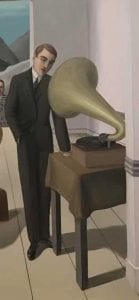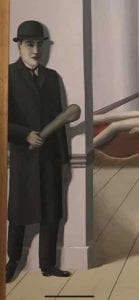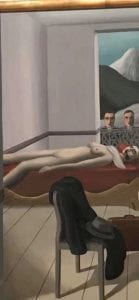Museum Trip: Art Inspiration
Picture:
Characters:
Housewife, Model, A young girl who just break up, A Retarded detector, A father full of hatred and wants to revenge. An actor, A character in a video game, A machine who record everything but not able to speak.
Central Conflict:
Who killed her and why? Machine v.s. Human. Time is running out. Who is the spy?
Genre:
Suspense, Thriller, Collaboration game, Comedy Show.
Location:
A museum, high school field trip, little town, drama play stage, Inside dream, Virtual reality simulation. A TV show.
Time:
The 1950s, Autumn, Morden, In the future after a fallout, A start of the zombie apocalypse.
——————————————————————————————
Fact about Magritte:
1. To support himself he spent many years working as a commercial artist. producing advertising and book designs, and this most likely shaped his fine art, which often has the abbreviated impact of an advertisement. https://www.theartstory.org/artist-magritte-rene.htm
2. Magritte preferred the quiet anonymity of a middle-class existence, a life symbolized by the bowler-hatted men that often populate his pictures. https://www.theartstory.org/artist-magritte-rene.htm
3. In later years, he was castigated by his peers for some of his strategies (such as his tendency to produce multiple copies of his pictures), yet since his death his reputation has only improved. https://www.theartstory.org/artist-magritte-rene.htm
4. The men in bowler hats that often appear in Magritte’s pictures can be interpreted as self-portraits. https://www.theartstory.org/artist-magritte-rene.htm
5. René Magritte was the eldest of three boys, born to a fairly well-off family. https://www.theartstory.org/artist-magritte-rene.htm
6. Magritte’s development as an artist was influenced by two significant events in his childhood; the first was an encounter with an artist painting in a cemetery, who he happened across while playing with a companion. https://www.theartstory.org/artist-magritte-rene.htm
7. Magritte later wrote, “I found, in the middle of some broken stone columns and heaped-up leaves, a painter who had come from the capital, and who seemed to me to be performing magic.” https://www.theartstory.org/artist-magritte-rene.htm
8. Magritte first began to paint in 1915 and enrolled in the Académie des Beaux-Arts in Brussels the following year. https://www.theartstory.org/artist-magritte-rene-life-and-legacy.htm
9. In 1921, Magritte performed his obligatory military service and returned home in 1922 to marry Georgette Berger, a girl he had known since childhood. https://www.theartstory.org/artist-magritte-rene-life-and-legacy.htm
10. Magritte’s work had a major impact on a number of movements that followed his death, including Pop, Conceptualism, and the painting of the 1980s. https://www.theartstory.org/artist-magritte-rene-life-and-legacy.htm
Fact about Technique:
1. While some French Surrealists experimented with new techniques, Magritte settled on a deadpan, illustrative technique that clearly articulated the content of his pictures. https://www.theartstory.org/artist-magritte-rene.htm
2. Repetition was an important strategy for Magritte, informing not only his handling of motifs within individual pictures, but also encouraging him to produce multiple copies of some of his greatest works. https://www.theartstory.org/artist-magritte-rene.htm
3. The illustrative quality of Magritte’s pictures often results in a powerful paradox: images that are beautiful in their clarity and simplicity, but which also provoke unsettling thoughts.https://www.theartstory.org/artist-magritte-rene.htm
4. Magritte was fascinated by the interactions of textual and visual signs, and some of his most famous pictures employ both words and images. https://www.theartstory.org/artist-magritte-rene.htm
5. Magritte combined the words and image in such a fashion that he forces us to question the importance of the sentence and the word. https://www.theartstory.org/artist-magritte-rene.htm
6. Magritte likely borrowed the pipe motif from Le Corbusier’s book Vers une architecture (1923), since he was an admirer of the architect and painter, but he may also have been inspired by a comical sign he knew in an art gallery, which read, “Ceci n’est pas de l’Art.” https://www.theartstory.org/artist-magritte-rene.htm
7. The vacantly staring figures and everyday objects, all rendered in Magritte’s flat, deadpan style, underscore what the Belgian abstract artist Pierre Flouquet characterized as the painting’s “banal crime.” https://www.moma.org/interactives/exhibitions/2013/magritte/#/featured/1/description
8. Like many of the Surrealists, Magritte was an avid fan of the pre–World War I popular crime fiction series Fantômas; he borrowed the placement of the two detective figures flanking the doorframe from Le Mort qui tue (The Murderous Corpse), a film from the series first released in 1913. https://www.moma.org/interactives/exhibitions/2013/magritte/#/featured/1/description
9. It was Magritte’s ambition to create a similarly immersive and fantastical world on the canvas, here made manifest in the unsolvable narrative of this enduringly mysterious painting. https://www.moma.org/interactives/exhibitions/2013/magritte/#/featured/1/description
10. His paintings were typically rendered in a simple but realistic fashion using proper perspective and light sources. http://www.rene-magritte.com/menaced-assassin/
Fact about Background:
1. Just as Magritte was achieving success and recognition, the Second World War broke out. https://www.theartstory.org/artist-magritte-rene-life-and-legacy.htm
2. Commercial transatlantic telephone service inaugurated between New York & London.
https://www.onthisday.com/events/date/1927
3. Royale Theater (Golden, CBS Radio Playhouse) opens at 242 W 45th NYC https://www.onthisday.com/events/date/1927
4. British expeditionary army lands in Shanghai https://www.onthisday.com/events/date/1927
5. US President Calvin Coolidge creates Federal Radio Commission (FRC) https://www.onthisday.com/events/date/1927
6. 1,000 US marines land in China to protect American property. https://www.onthisday.com/events/date/1927
7. International Economic Conference (52 countries including USSR) opens https://www.onthisday.com/events/date/1927
8. Belgium beats England 9-1 in soccer. https://www.onthisday.com/events/date/1927
9. In 1927, Einstein and Bohr were two of the 29 scientists (more than half of whom were or would later become Nobel Prize recipients) in attendance at the Fifth Solvay Institut International de Physique in Brussels to discuss the foundations of the newly formed quantum theory. https://www.businessinsider.com/solvay-conference-1927-2015-4
10. Netherlands beats Belgium 3-2 in soccer match in Amsterdam. https://www.brainyhistory.com/topics/b/belgium.html



